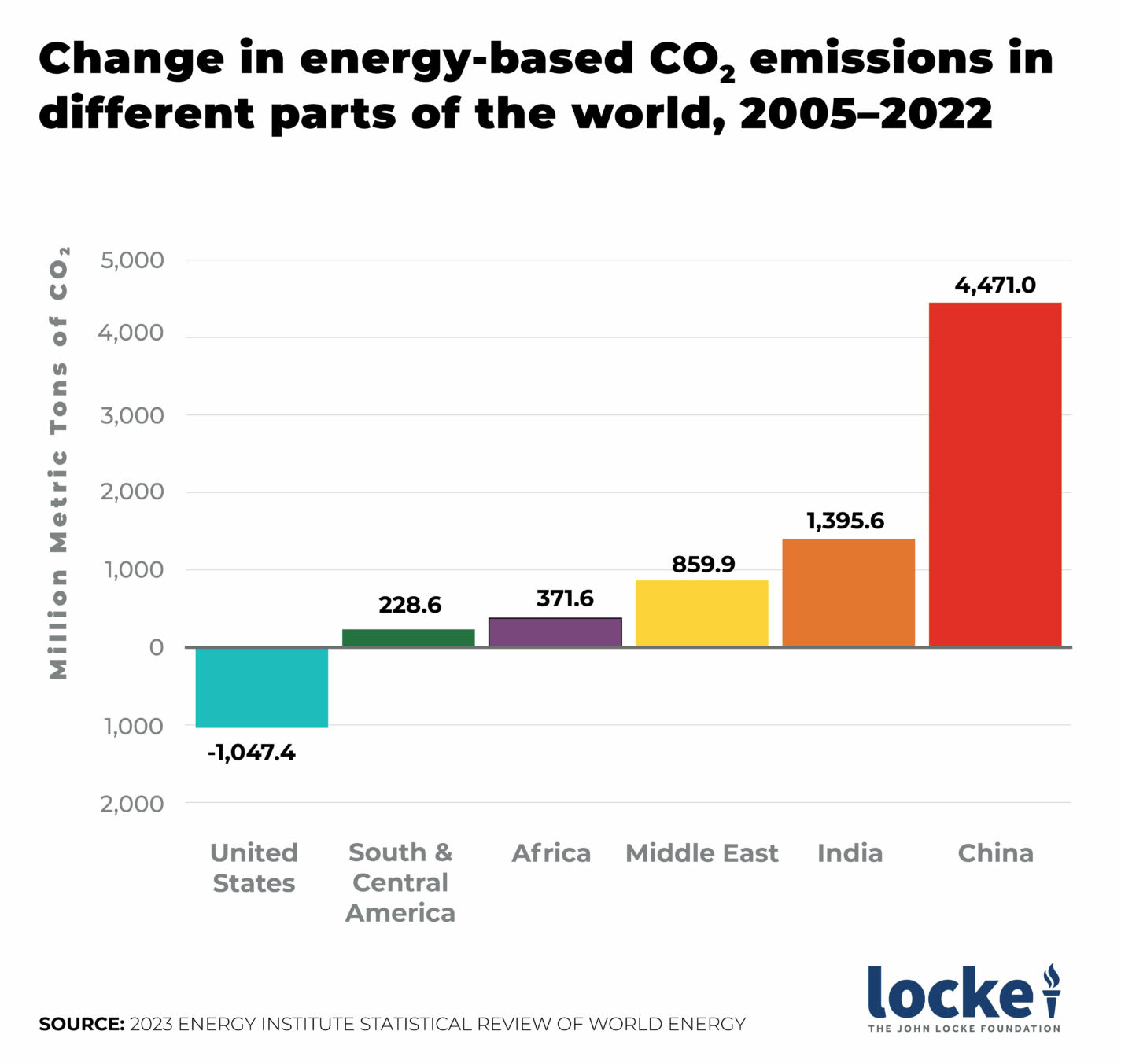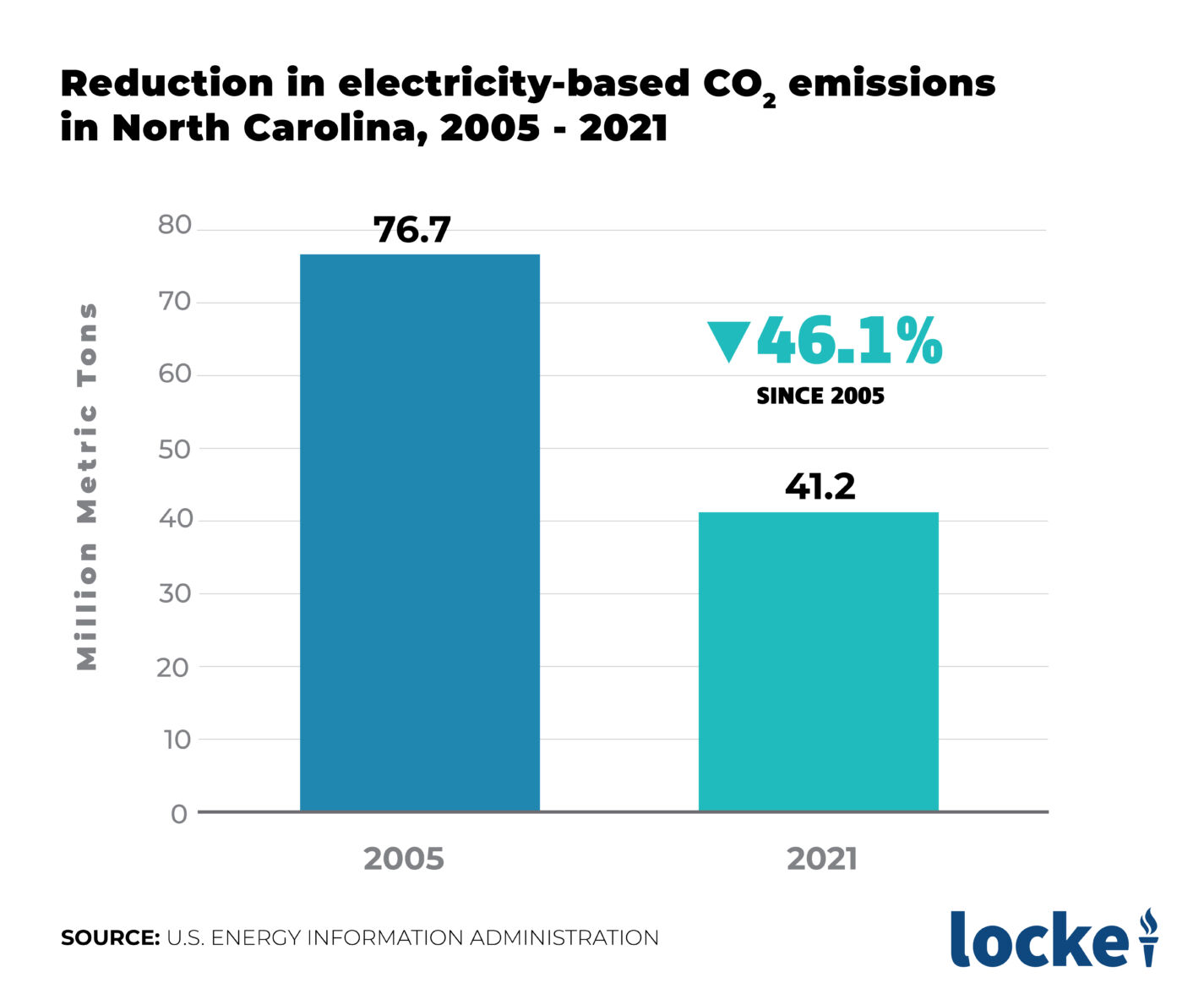- The Biden administration seeks to fund extreme environmentalist initiatives at the state level, including cap and trade programs
- Such programs amount to “an energy-rationing scheme that acts as an energy tax”
- In a provision in the state budget, the General Assembly wisely prevented the governor and state agencies from requiring cap and trade programs
This year’s state budget included a provision that prevents unelected state bureaucrats, either within or outside of North Carolina, from essentially creating and imposing taxes quite explicitly out of thin air.
Here is the provision:
§ 143-215.107E. Prohibit cap and trade requirements for carbon dioxide (CO2) emissions.
Neither the Governor, nor any of the agencies of the State, including the Utilities Commission, the Department of Environmental Quality, and the Environmental Management Commission, may require an electric public utility, as defined in G.S. 62-126.3(7), or persons who operate an electric generating facility the primary purpose of which is for the person’s own use and not for the primary purpose of producing electricity for sale to or for the public for compensation, to participate in a program that requires such utilities to obtain allowances to offset their CO2 emissions, commonly characterized as emissions cap-and-trade programs, CO2 budget trading programs, or cap-and-invest initiatives. In addition, the Governor and the Department are expressly prohibited from entering into any agreement with other states obligating North Carolina’s participation in any program requiring acquisition of allowances to offset CO2 emissions by such utilities.
Here is why such a provision is necessary. In September 2023 the U.S. Environmental Protection Agency under Pres. Joe Biden announced a $4.6 billion “Climate Pollution Reduction Grants” program that would fund a wide range of initiatives at the state level. The favored initiatives are things environmentalists have been unable to impose at the federal level. As Washington Examiner reported, they include “a clean electricity standard, cap and trade programs, carbon taxes, streamlining permitting for renewable energy projects, and more.”
Gov. Roy Cooper would welcome them all, of course. North Carolina already has a “clean electricity standard” in the form of a 2021 state law. It put into statute the “Clean Energy Plan” Cooper wanted to install by executive order that would have North Carolina’s electricity generation be “carbon-neutral” by 2050. The law, however, did what the governor would not: install the guardrails of least-cost provision and reliable service to keep from indiscriminately shutting down traditional power plants in a rush and burdening state ratepayers with overbuilding expensive, unreliable solar and wind facilities.
The North Carolina General Assembly followed up last year with another law — passed over Cooper’s telling veto — to define zero-emissions nuclear power as clean energy.
So far, North Carolina does not have a cap and trade program or taxes on carbon dioxide (CO2) emissions. In 2020 Cooper pledged with California Gov. Gavin Newsom to have North Carolina adopt California’s automobile regulations and “transition” to electric cars, trucks, and buses, but the governor doesn’t have that authority. The General Assembly doubly blocked it with explicit language in the budget. Meanwhile, California moved to outlaw the sales of new gas-powered cars by 2035, joined by several other states whose governors had, like Cooper, agreed to Newsom’s “Memorandum of Understanding.” The General Assembly’s emphatic, constitutional “no” is keeping North Carolinians from that foolish fate.
So with a governor bent on serving the interests of environmental zealots to the detriment of his constituents, the people of North Carolina, and with the federal government waving money at the states to impose those same zealots’ wishes, it’s very good for North Carolinians that the General Assembly implemented the law forbidding the governor and any state agencies from imposing cap and trade programs. It also prevents them from signing agreements with other states (such as California) obligating participation in such programs.
Cap and trade: the “market” approach that isn’t
Cap and trade programs have been pushed by environmentalists under the guise that it’s a market approach. Instead, it is “an energy-rationing scheme that acts as an energy tax” in which “the government would cap the amount of total carbon dioxide emissions” and “[r]egulated parties would have to own a permit to emit each ton of CO2. If a regulated entity does not have enough permits, it can buy permits from other regulated entities.” Being able to trade these governmentally created “permits” to emit the same gas that animals and people exhale is the flimsy basis for the programs being called “market-based.”
“Cap and trade does sound friendlier than CO2 rationing or carbon taxes. But at its core, this regulatory regime encompasses both.”
The Fraser Institute explained why the “Cap and trade is not a market-based solution.” The program aims to reduce CO2 emissions on the theory that so doing so would mitigate climate change. As Diane Katz writes for Fraser:
Under a cap-and-trade program, the government sets an overall limit (cap) on emissions. Based on that cap, quotas are imposed on individual sources of emissions, such as utilities and factories. The government allocates allowances to each facility that represents the volume of their quota. A facility must either reduce emissions to meet the quota or purchase allowances from those that have exceeded their required reductions (trade). …
Cap and trade does sound friendlier than CO2 rationing or carbon taxes. But at its core, this regulatory regime encompasses both. It is based on the creation of a scarcity by government fiat (the cap on CO2 emissions) and the rationing of remaining supply through government-imposed quotas. The cost of compliance constitutes a tax by raising the cost of carbon-based fuels to curtail use.
The precise levels at which the overall cap and the quotas ultimately are set are wholly arbitrary.
Katz described other decidedly antimarket features of a cap and trade program:
- It would favor big corporations (who are more able to afford the extra costs and deal with the regulations) over smaller firms
- It would raise prices on consumers
- It would be “a massive wealth transfer from consumers to business”
- It would enrich some companies by “brokering emissions credits”
- It would raise tremendous entry barriers to newcomers in the market — without a free allowance from the government, they’d start at the disadvantage of buying permits from competitors
- Permit prices would likely fluctuate wildly
- The added uncertainty would drive out investment
As Katz summed it up,
Government rationing of carbon-based emissions should not be confused with voluntary conservation options. The principle difference is that under cap and trade, the government would not offer citizens the choice of participation and would force us to pay the cost. That’s not how the market works.
Expensive and Ultimately Pointless
Regardless of Biden’s goals, there’s no reason to think forcing faster CO2 reductions in the U.S. could help the world’s climate — not even under the most doctrinaire climate change theory.
That’s because, since 2005, and with help from North Carolina, the U.S. has reduced energy-based CO2emissions more than any other nation on earth — and also because most of the world (especially China) has kept increasing CO2 emissions:


Raising our prices, taking away our cars, and adding other expensive regulations on us can’t have any effect on the world’s climate. They only make our lives worse off.


